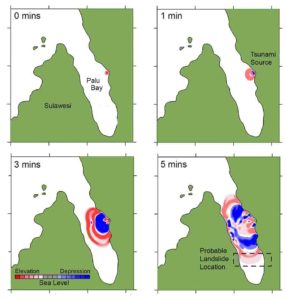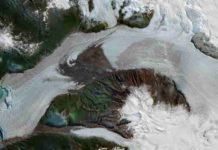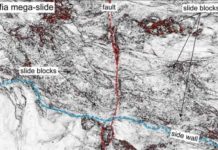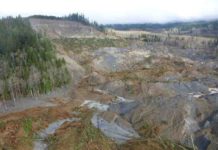
September’s deadly Indonesian tsunami, which killed almost 2000 people, was probably caused by a huge submarine landslide off Sulawesi Island’s west coast, a new study shows.
Until now, scientists have been left puzzled by how an earthquake of just 7.5 magnitude – not significant enough to trigger Indonesia’s tsunami early-warning system – was able to wreck such devastation.
But a new analysis of wave data by researchers at Brunel University London has pinpointed an area in Palu Bay, on Sulawesi Island’s west coast, as the probable location of a massive under water landslide caused by the earthquake.
“This event is puzzling for two reasons,” said Dr. Mohammad Heidarzadeh, Assistant Professor of Civil Engineering at Brunel, who led the study.
“Firstly, the earthquake’s magnitude was moderate. Usually an earthquake would require a magnitude of at least 8.4 or 8.5 to trigger such a large tsunami – at peak the wave reached 11 metres. Secondly, the mechanism of the earthquake’s rupture was a strike-slip – the ground ruptured horizontally, rather than vertically.
“This is confusing as we’d have therefore expected a wave of only 1 or 2 metres from a Sulawesi-style earthquake.”
However, the new study – published in the journal of Pure and Applied Geophysics – now shows the earthquake likely did trigger a landslide large enough to unleash the devasting tsunami.
New sea-level analysis shows that the Sulawesi tsunami had very short-period waves, in-line with those caused by a landslide. Where tsunamis caused by landslides typically have a wave period of 3 to 4 minutes, tsunamis unleashed by an earthquake will have a wave period of 15 to 60 minutes.
Field studies also revealed that the largest waves were concentrated on just a small segment of coast, which is consistent with the tsunami being caused by a landslide.
“Our analyses are based on sea-level data of real waves generated by the Sulawesi tsunami, analysis of the seafloor rupture and deformation generated by the earthquake, and computer simulations of the real tsunami propagation,” said Dr. Heidarzadeh.
The study also ruled out another proposed theory for the cause of the tsunami – the funnelling of water up the bay, or bay oscillations.
“Our analysis completely ruled out those speculations,” said Dr. Heidarzadeh. “We proved that bay oscillations cannot make 11 metre high waves.”
null
Reference:
Mohammad Heidarzadeh et al. Insights on the Source of the 28 September 2018 Sulawesi Tsunami, Indonesia Based on Spectral Analyses and Numerical Simulations, Pure and Applied Geophysics (2018). DOI: 10.1007/s00024-018-2065-9
Note: The above post is reprinted from materials provided by Brunel University.










